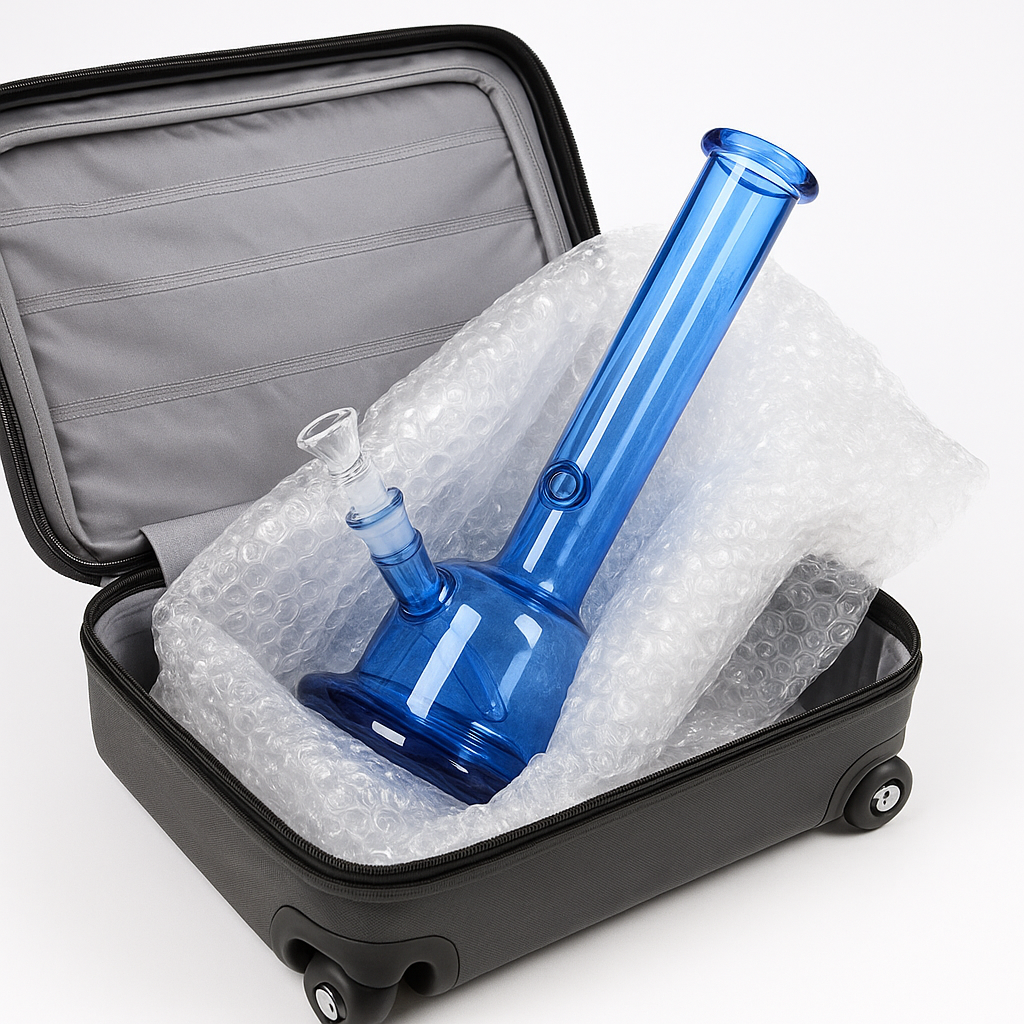Ever unzipped your suitcase to find your beautiful glass piece reduced to glitter? That shock, the wasted money, and the scramble for a replacement can ruin any business trip. Relax—there is a way to keep your glass safe while you hop from trade show to trade show.

Traveling with glass pipes and bongs is perfectly legal in most markets, provided they’re clean and well-packed. The trick is layering soft, shock-absorbing materials—think bubble-wrap, foam inserts, and sturdy cases—so vibrations and hard knocks never reach the glass. Follow a few science-backed steps and you can check fragile stock with confidence.
Let’s dive in.
What is “travel-ready” glass?
In our industry, “travel-ready” means borosilicate pieces designed with thicker walls (≥5 mm) and reinforced joints. These bongs survive rapid temperature shifts and resist hairline cracks far better than soda-lime glass.
Travel-ready glass is any borosilicate pipe or bong with 5 mm-plus wall thickness, a wide base, and reinforced joints—tough enough for bumps yet light enough to carry.
Why does it matter?
Each year, glass injuries cost buyers millions in write-offs and shipping claims. A single cracked beaker can erase the profit on an entire order.
Choosing travel-ready glass slashes breakage rates, lowers insurance premiums, and keeps your delivery schedule on track—vital for B2B buyers working tight margins.
PubMed injury stats — “over 2.5 million glass-related injuries annually”
How to choose the right protection?
Start with the carrier: carry-on if possible, checked luggage in a hard-shell case if not. Inside, layer wraps and dividers so nothing shifts.
Pick a crush-proof case, wrap each piece in 2-3 layers of bubble-wrap, add foam or clothing buffers, and keep joints upright to prevent stress.
–––
What mistakes should beginners avoid?
The two biggest pitfalls are dirty glass (which screams “drug paraphernalia” to inspectors) and loose packing that lets pieces rattle.
Avoid traveling with resin-stained pieces, single-layer wrapping, and overstuffed cases—these three errors cause 80 % of breakage claims.

Dive deeper
1. Know the rules
- TSA allows glass in carry-ons and checked bags as long as it contains no residue. https://www.tsa.gov/travel/security-screening/whatcanibring/items/glass
- Shipping commercial freight? Follow DOT fragile-goods packaging rules (49 CFR §173.24). https://www.phmsa.dot.gov/sites/phmsa.dot.gov/files/2022-06/Transporting-Infectious-Substances-Safely.pdf
- International shows? Check local paraphernalia laws via NORML’s state guide. https://norml.org/laws/
2. Materials matter
Borosilicate expands half as much as soda-lime when heated, giving it superior thermal-shock resistance. https://sgt.org/resource/resmgr/compendium_of_glass/79_parker.pdf
At 5 mm thickness, fracture strength jumps roughly 30 %—enough to survive most luggage drops. https://www.osha.gov/sites/default/files/publications/osha2236.pdf
3. Five-layer packing method
- Inner wrap – soft microfiber to prevent scratches.
- Bubble-wrap burrito – two full revolutions at minimum.
- Rigid sleeve – PVC pipe or cardboard tube around the body.
- Void fill – foam peanuts or rolled tees.
- Case shell – hard-sided suitcase or Pelican-style box.
4. Cleaning before you go
Residue invites extra scrutiny and—even worse—odour that seeps into clothes. A quick salt-and-ISO rinse followed by hot water is enough.
CDC guidelines advise triple-rinsing any item contaminated with organic material before transport. https://www.cdc.gov/infectioncontrol/guidelines/disinfection/index.html
5. Insurance & documentation
Declare “fragile scientific glassware” on commercial invoices—it’s accurate, non-incriminating, and speeds claims. Keep purchase receipts handy; many carriers refund broken items if value is documented.
Conclusion
With the right glass, smart packing, and a dash of prep work, traveling doesn’t have to be risky. Protect your inventory—and your profits—and you’ll land ready to wow clients with pristine samples.






